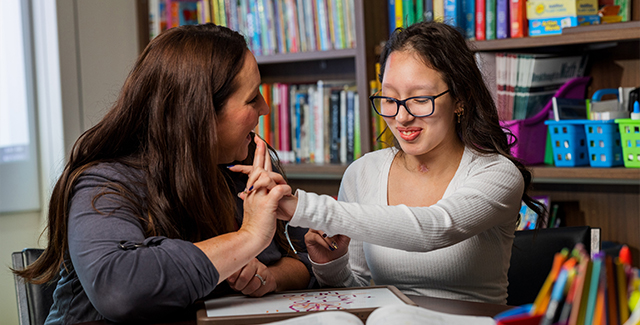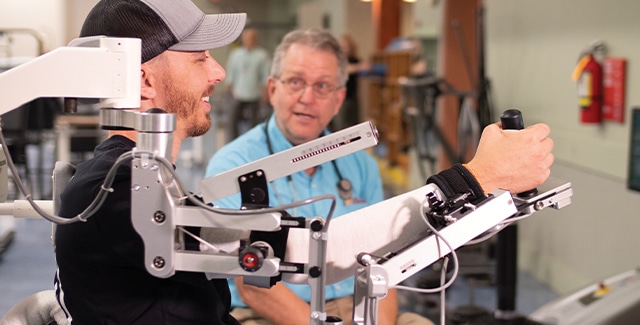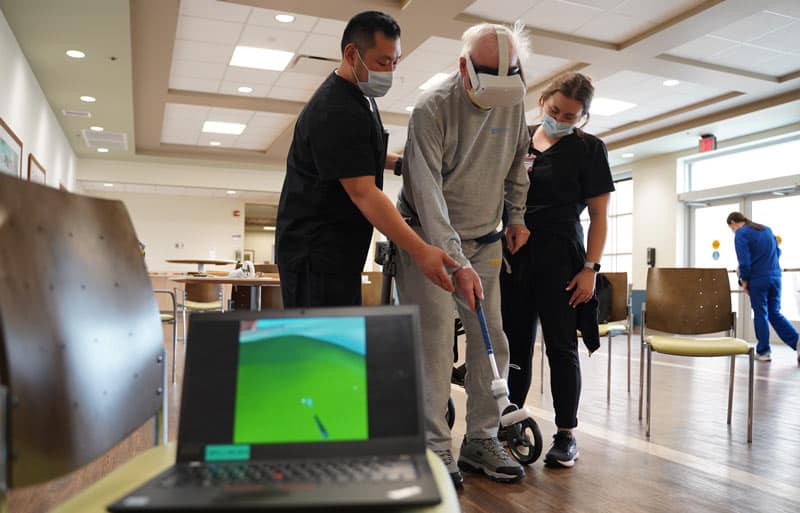At Madonna, we pride ourselves on being on the leading edge of rehabilitation technology. Recently, we’ve begun stepping into the world of virtual reality (VR), using the Meta Quest Pro system and Oculus headsets.
Madonna has been incorporating the Meta Quest 2 into therapy for nearly a year. The program utilizes an Oculus headset and two hand controllers that fully immerses an individual into a VR environment. The user creates an avatar and can then participate in gaming, connecting with long-distance friends, business meetings, or displaying their creativity through arts and crafts. Through generous donations during Madonna Miracle Night, we were able to upgrade to Meta Quest Pro, with an enhanced digital display, longer battery life, easier to grip controllers and better tracking capability.
In addition, our friends and donors helped the therapy department purchase vision rehabilitation technology to identify and improve outcomes for visual deficits, utilizing the Microsoft Hololens which is an augmented reality (AR) device. This technology allows for both AR utilizing “pass-through” for real-time view and also VR for full immersion with cameras inside the headset for use of eye tracking. The pass-through function in VR is a key safety feature, and refers to the ability of the headset to display real-world images in real time, allowing users to see their surroundings from within the headset while still being able to interact with virtual objects. The pass-through functionality can also be used for navigation, as it allows users to see obstacles in their path. Therapists can use the data captured with eye tracking to collaborate with Madonna’s on-sight neuro-optometrists to make decisions on what visual deficits to target and work on with a patient. Since 80% of the sensory information all of us utilize comes from our visual system, investing in technology to support this area of rehabilitation will allow Madonna to take our vision program to the next level.
Through VR and AR, therapy can provide a safe space for users to participate in and move through immersive work and play. If the user steps outside the designated play area, the headset provides a “pass-through,”of real-world objects and potential obstacles around them. Therapists can cast video feed from the headset to a TV, phone, computer or laptop. This allows the therapist to see exactly what the user sees, guide them through the simulation and anticipate obstacles.
Tyler Pribnow, a Madonna occupational therapist, has been helping pioneer the use of this technology by incorporating it into therapy sessions.
“Virtual reality can be utilized in therapy to improve range of motion and neuromuscular re-education through upper and lower extremity function, activity tolerance and balance for standing and sitting, bending and reaching, acute and chronic pain management or orthopedic injuries,” he said. “We can utilize virtual reality for task-specific activities, for example a grocery store activity, driving or golf. And, for variable practice that allows the user to participate in a variety of repetitive movements and tasks through the extremities to improve gross motor coordination.”
Research has shown a positive correlation between the utilization of VR and AR in therapy and improved patient outcomes. This is especially true in regard to improvements in motivation and greater readiness to return to community engagement. “The technology allows the individual the chance to return to leisure and recreational activities that they believed they would never be able to participate in again,” Pribnow said. “The goal is to improve independence and show patients they can return to life roles and hobbies that give their life meaning.”
So far, Pribnow has used virtual reality technology in a variety of situations. He utilized applications like “SimplePlanes VR” which allowed a patient to return to the cockpit and fly a plane virtually, “Golf+” which allowed individuals to participate in putt-putt golf, a driving range or play 9 holes of golf, “Rec Room” where they can participate in bowling, board games and even dodgeball, or “Painting VR” that allowed those with an artistic or creative side to paint 2D or 3D pictures. He hopes to continue to explore opportunities for integrating virtual reality technology into therapy and research the impact it has on patient outcomes.
“The possibilities are really endless, and I’m excited to see just how far we can go with it,” Pribnow said.





